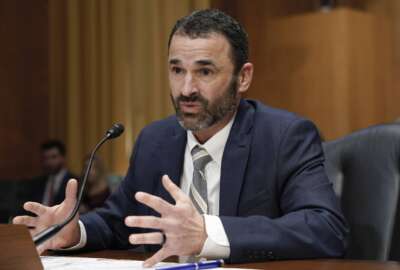Hubbard Radio Washington DC, LLC. All rights reserved. This website is not intended for users located within the European Economic Area.
On Air: Federal News Network
Trending:
Army spends $500 million per year on vacant facilities
The Army is the first service to begin an analysis of its excess real estate after a Congressional prohibition against even studying the subject expired. Early ...
wfedstaff | April 17, 2015 6:31 pm
The Army says its early analyses of its excess base infrastructure show it is wasting at least a half billion dollars per year on facilities it no longer uses nor needs. And that figure that is certain to climb as the service gets smaller in the coming years.
Over the course of several consecutive annual budget submissions, the Defense Department has put front-and-center its need to reduce its excess infrastructure through another round of base realignments and closures.
Lawmakers hostile to BRAC placed language in prior years’ Defense authorization bills that banned DoD from even studying or planning for a potential infrastructure consolidation, leaving the department short on data to make its case.
That language was left out of this year’s bill though, and the Army is the first service to begin an analysis of its excess capacity. The Army says among its United States bases, preliminary results show it has anywhere between 12 and 28 percent more than it needs, depending on the type of facility.
“We call it the empty facilities tax,” Army Secretary John McHugh told the House Appropriations Committee Thursday. “You have to maintain buildings to a certain level even though you’re not using them.”
End strength totals the real driver
In Europe, the tally of unused facilities is anywhere between 10 and 15 percent. The Army already has begun the process of closing bases there, because it does not need Congressional approval to do so.
Following the 2005 BRAC round, which mostly moved forces to other locations rather than completely closing bases, 80 percent of the Army’s troops now are stationed in the United States.
The $500 million figure is based on the current state of the Army’s downsizing effort as it draws down from an end strength of 570,000 soldiers. The service’s ultimate size remains uncertain with potential sequestration still on the horizon in 2016 and thereafter, but McHugh said one way or another, the Army will continue to shrink, and its number of unused stateside buildings will grow.
“We’re already scheduled to come down to 490,000 by the end of ’15 and then from 440,000 to 450,000. So just by definition, as fewer troops are in those buildings, more and more space will become excess,” he said. “We want to minimize that, but we will always stay within the law. We have prerogatives of certain things we can do with respect to structure that the Congress has provided us, and as we go forward, we’ll try to use those. But an ultimate BRAC, which is the most efficient way in which we wisely spend taxpayers’ dollars and which we receive the most savings is, in our judgment, the most sensible path to take. But we need your authorization to do that.”
McHugh did not specify the legal “prerogatives” the Army would consider using in the absence of a Congressionally-authorized BRAC round, but the Army so far has not moved on its own to close any excess infrastructure.
Instead, it is in the process of reorganizing its brigade combat teams. It announced last year that it would eliminate 10 of its 45 brigades in order to reduce the number of headquarters units and consolidate force elements into the brigades that remain. The service already began that process, which is expected to yield even more unused office space.
“Without a BRAC what we do is create more excess rather than fewer. We keep facilities, but there are no people in them,” he said. “There is no use for those facilities, and yet we still have to maintain them. The process that we’re going through right now of drawing down forces, of creating more vacancies in our facilities actually will drive that $500 million up. A BRAC would allow us to go about it in a far more sensible way, would allow us to make rational decisions so that we can concentrate our facility excess and to a great extent as possible get it off the books, saving us rather than costing us money.”
5,000 could be involuntarily separated
McHugh acknowledged a new BRAC round would require initial spending to cover the costs of closing excess facilities, but he said each of the prior rounds of closures had yielded at least a 7.7 percent return on investment, including the 2005 round in which DoD vastly underestimated the up-front costs of the project.
Because sequestration still hasn’t been resolved beyond fiscal 2016, the Army doesn’t know precisely how much facility support it will need, because it doesn’t know how large a force it will be able to afford. The budget plan it sent to Capitol Hill last month would pay for a force of between 440,000 and 450,000 soldiers, but the sequestration caps in current law would limit it to 420,000 soldiers.
Those final budget numbers will determine the speed at which the Army will have to shrink.
Gen. John Campbell, the Army’s vice chief of staff, said the Army already estimates it will have to involuntarily separate at least 5,000 soldiers in order to meet its existing drawdown figure of 490,000 troops. And it will have to send home at least 35,000 against their wishes just to hit DoD’s optimistic target of 450,000 in the next few years.
“If we go to 420,000, that number’s going to go up more,” Campbell told the Senate Armed Services Committee on Wednesday. “We’ve put our colonels and lieutenant colonels through selective early retirement boards this year, but all of those were eligible for retirement, and we worked that with some great counseling, and it was about 150 lieutenant colonels, probably 100 colonels. But now we’re now working on captains and majors, and those numbers will be much larger. These are young captains that could be company commanders in Afghanistan today. They’re going to come back and we’re going to tell them, ‘Hey, thanks for your service.’ It’s going to be very, very tough.”
With regard to BRAC, even without the benefit of deep analysis, the military services think they are in varying positions with respect to excess infrastructure.
The Air Force might be dedicating even more money to the upkeep of empty buildings than the Army. That service has not yet conducted a new capacity study, but the last one, in 2004, found it had 24 percent more infrastructure than it needed. No major Air Force bases have closed since then, and the service’s end strength has declined by 8 percent in the meantime.
The Navy says it supports DoD’s request for another BRAC round, but as a service unto itself, it is in a very different position, as Adm. Jonathan Greenert, the Chief of Naval Operations, delicately told reporters in Jacksonville, Fla., last week.
“I’ve got to watch the words here, but I’m very satisfied with the laydown of our bases around the world,” he said, following an all-hands call with sailors at Naval Station Mayport. “I don’t see excess capacity in large numbers. If people ask me, ‘Do you have a great need for BRAC?’ I say, ‘No, I don’t, but it’s a decent process because it’s a deliberate, analytically-based process.’ We’re not pushing it here in the Navy, but if done, we’ll contribute to it and we’ll comply.”
RELATED STORIES:
DoD maintains BRAC fight, despite opposition from Congress
BRAC cost 67 percent more than DoD’s original estimates, GAO finds
Military facilities get shorted as part of DoD’s 2015 budget choices
Copyright © 2024 Federal News Network. All rights reserved. This website is not intended for users located within the European Economic Area.
Jared Serbu
Jared Serbu is deputy editor of Federal News Network and reports on the Defense Department’s contracting, legislative, workforce and IT issues.
Follow @jserbuWFED





